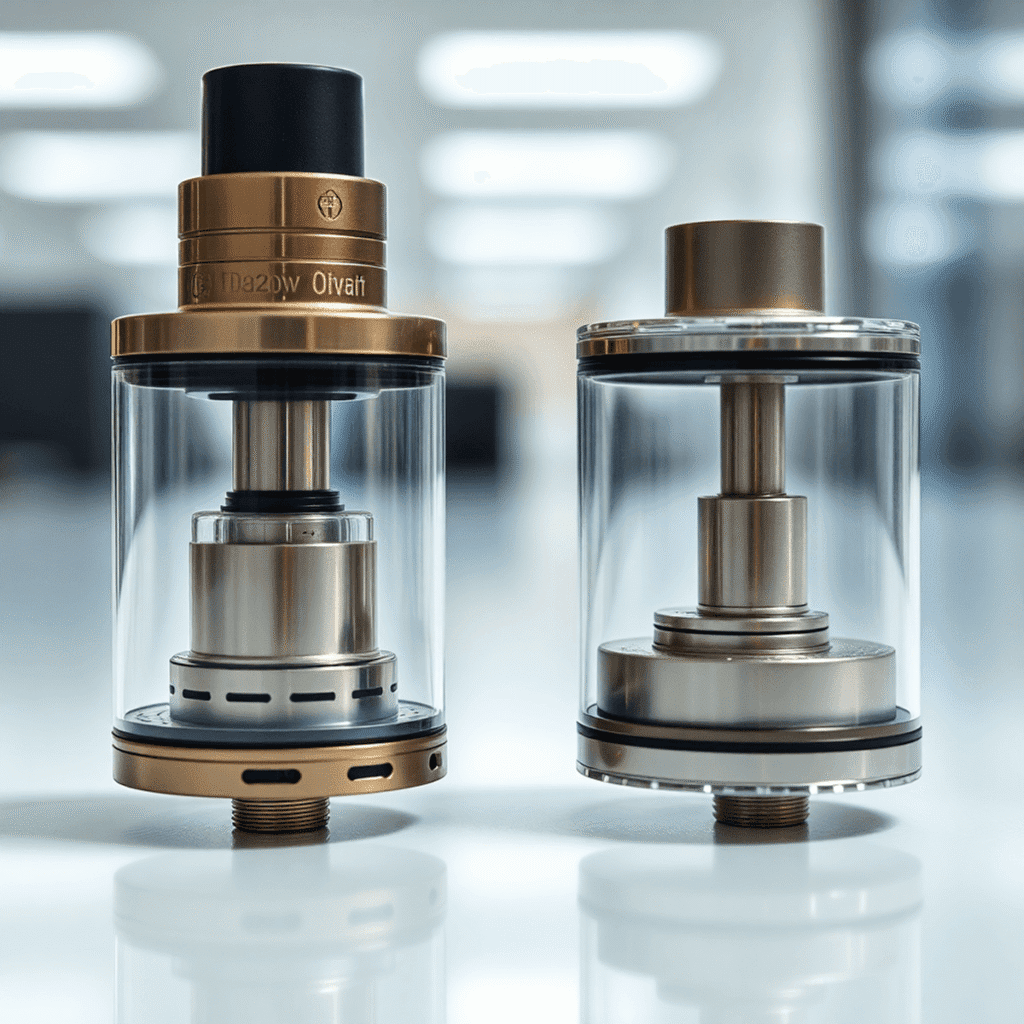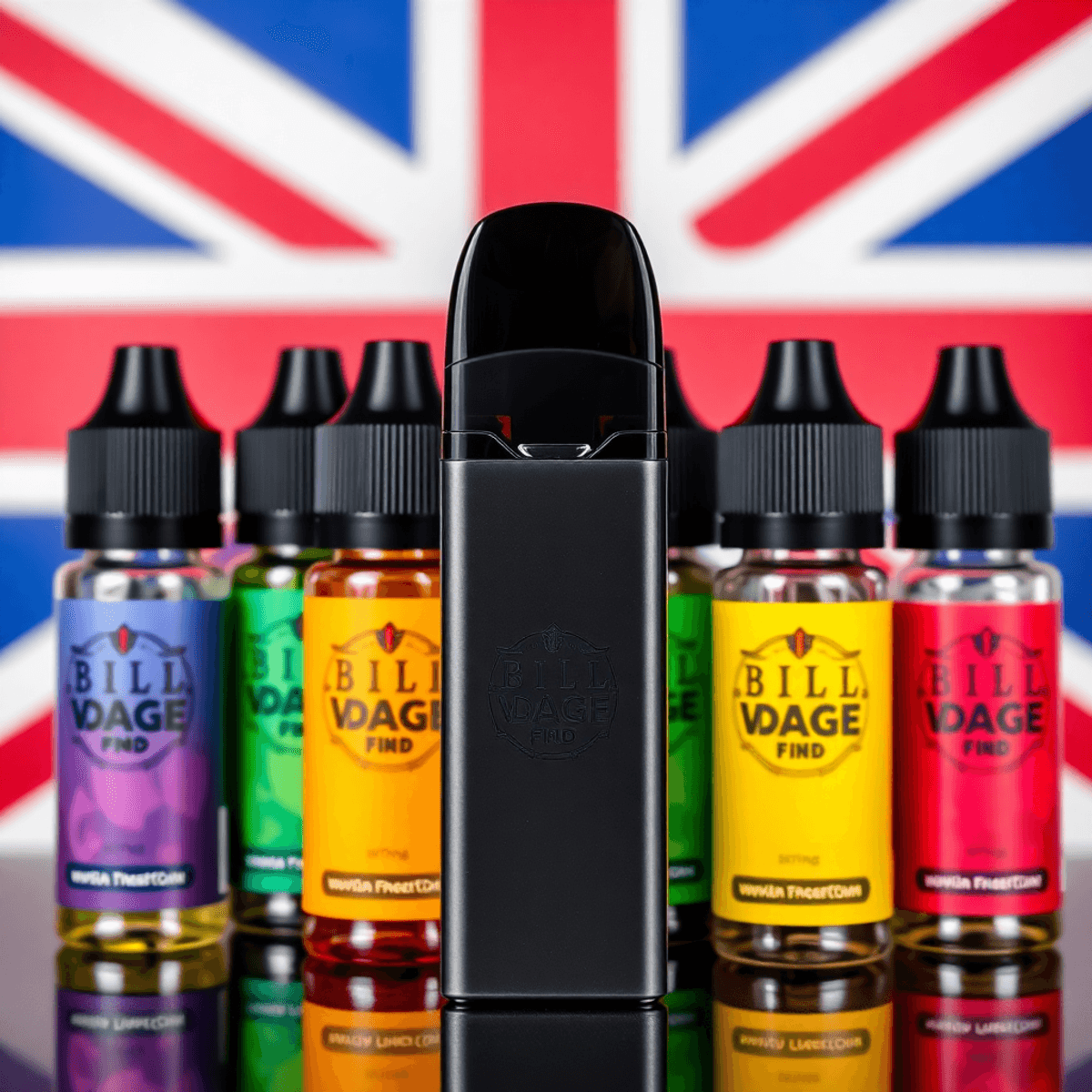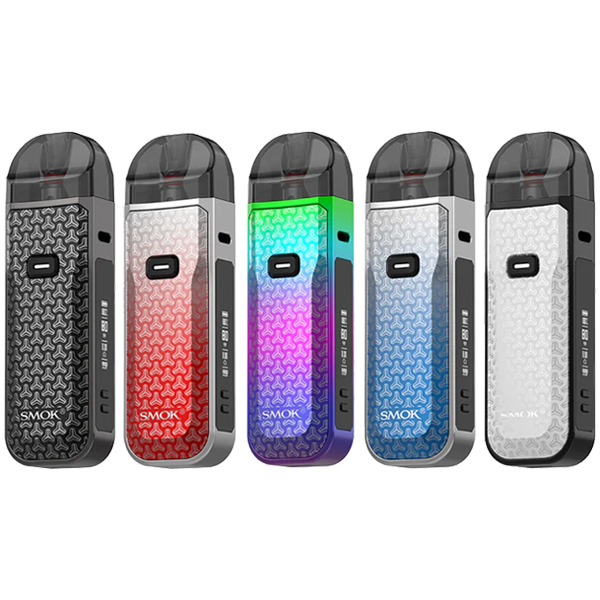Starting your vaping journey can feel overwhelming with the variety of tanks available. Two main contenders stand out for beginners: Sub-Ohm tanks and MTL (Mouth-to-Lung) tanks. Your choice between these options shapes your entire vaping experience.
Think of vape tanks as the heart of your device – they house the coil, hold your e-liquid, and determine how you’ll inhale the vapour. MTL tanks mimic the draw of traditional cigarettes, making them a natural choice for those transitioning from smoking. Sub-Ohm tanks, with their direct-to-lung hit and impressive cloud production, offer a different experience entirely.
The right tank choice can make or break your vaping satisfaction. MTL tanks deliver a familiar sensation with controlled vapour production, while Sub-Ohm tanks provide intense flavour and substantial clouds. Each type brings unique characteristics to the table:
- MTL Tanks: Tighter draw, higher resistance coils
- Sub-Ohm Tanks: Looser draw, lower resistance coils
Let’s explore these differences to help you make an informed decision for your vaping journey. Additionally, whether you’re seeking advice or looking for comprehensive guides on various aspects of vaping, we have you covered. And don’t forget to explore our wide range of flavours that can enhance your vaping experience!
Understanding Vape Tanks
A vape tank consists of several essential components working together to deliver your chosen e-liquid. Let’s break down these key parts:
Main Components:
- Clear Tank Section: Houses your e-liquid and allows you to monitor fluid levels
- Chimney: Channels vapour from the coil to the drip tip
- Drip Tip: The mouthpiece where you inhale vapour
- Bottom Section: Contains the coil housing and airflow control
- Coil: The heating element that vaporises your e-liquid
Coil Resistance
Your coil’s resistance, measured in ohms (Ω), determines how much power flows through your device. Lower resistance coils (below 1.0Ω) create more vapour and warmer hits, while higher resistance coils (above 1.0Ω) provide a cooler, more controlled experience.
Airflow Impact
The airflow system shapes your vaping experience:
- Tight airflow creates a restricted draw perfect for MTL vaping
- Wide-open airflow delivers airy draws ideal for direct-lung hits
- Adjustable airflow rings let you fine-tune your experience
E-Liquid Compatibility
Different tanks work best with specific e-liquid ratios:
MTL Tanks
- 50/50 VG/PG ratio
- Higher nicotine strength (6mg-20mg)
- Thinner consistency
Sub-Ohm Tanks
- 70/30 VG/PG ratio or higher
- Lower nicotine strength (0mg-6mg)
- Thicker consistency
Understanding these components helps you make informed decisions about your vaping setup and ensures you match the right e-liquid to your chosen tank style.
If you’re looking to explore different vaping devices, consider checking out advanced options like the Elf Bar ELFX Pro Classic Pod Vape Kit, which is designed to elevate your vaping experience with advanced capabilities.
Also, if you’re new to vaping or even considering transitioning from smoking, our comprehensive guide on how to quit smoking could provide valuable strategies for a healthier tomorrow.
For those interested in knowing more about the caloric content of vaping, our article on how many calories are in a vape might be of interest.
Lastly, if you’re seeking guidance on popular vape brands in the UK market, our detailed guide to the top vape brands across the UK can help you navigate through well-known names and emerging companies in the industry.
Mouth-To-Lung (MTL) Tanks
MTL tanks mirror the experience of traditional cigarette smoking, making them a natural choice for beginners transitioning from smoking to vaping. These tanks typically feature coil resistance above 1.0 ohm, creating a familiar draw that feels like pulling on a cigarette.
The restricted airflow design of MTL tanks produces a concentrated flavour profile while limiting vapour production. You’ll notice small air holes at the base of the tank – a deliberate design choice that creates the perfect resistance for mouth-to-lung inhaling. This design stands in contrast to direct-to-lung vaping, which is more suited for advanced users.
E-Liquid Compatibility
- Higher PG content (50/50 or 60/40 PG/VG ratio)
- Nicotine strengths ranging from 3mg to 20mg
- Nic salt options available for smoother throat hit
Key Benefits for New Vapers
- Familiar draw resistance
- Enhanced flavour delivery
- Reduced e-liquid consumption
- Lower power requirements
- Extended battery life
- Minimal vapour production
The higher resistance coils in MTL tanks operate effectively at lower wattages (10-25W), reducing the risk of harsh hits or overwhelming vapour clouds. This conservative power consumption translates to longer battery life and a more economical vaping experience.
MTL tanks shine in their ability to deliver satisfying nicotine hits with minimal vapour, making them ideal for discreet vaping. The concentrated flavour production lets you fully appreciate your chosen e-liquid while maintaining a comfortable throat hit similar to traditional cigarettes.
For those looking to explore advanced options, consider trying out the Vaporesso XROS 3 Pod Kit, which offers enhanced features and performance. Additionally, if you’re interested in experimenting with nic salts, the Vaporesso GT Cores GT2 Coil 0.4Ω is an excellent choice known for its compatibility with nic salts.
For further insights and reviews on various vaping products, feel free to check out our comprehensive reviews section.
Sub-Ohm Tanks
Sub-Ohm tanks represent a significant leap in vaping technology, featuring coils with resistance below 1.0 ohm. These tanks deliver powerful performance through their distinctive characteristics:
Key Features:
- Wide-bore drip tips for enhanced airflow
- Large juice wells to accommodate higher consumption
- Adjustable airflow systems with multiple intake slots
- Sophisticated coil designs for optimal heat distribution
Sub-Ohm tanks require specific e-liquids to perform at their best. You’ll need juices with:
- 70% VG content or higher
- Nicotine strength of 6mg or lower
- Thicker consistency for better wicking
The power of Sub-Ohm tanks brings distinct advantages:
- Rich, intense flavour profiles
- Substantial vapour production
- Warmer vape temperature
- Smoother throat hit
Essential Considerations:
- Higher e-liquid consumption
- Increased battery usage
- Regular coil replacement needed
- Greater power demands (minimum 40W)
While Sub-Ohm tanks might seem intimidating, modern safety features make them accessible to beginners. Popular starter-friendly options include the Vaporesso LUXE Q Replacement Pods which come in resistance options of 0.8Ω and 1.2Ω, both offering user-friendly designs with advanced performance capabilities.
Your device needs to support Sub-Ohm vaping – check compatibility with batteries rated for at least 20A continuous discharge. The higher power requirements mean you’ll need to carry spare batteries or ensure frequent charging. If you’re considering a more advanced setup, you might want to explore what a vape mod is and how it could enhance your vaping experience.
Factors Influencing Tank Choice
Choosing between MTL and Sub-Ohm tanks requires careful consideration of several key factors that directly impact your vaping satisfaction.
1. Throat Hit Intensity
Your desired throat hit plays a crucial role in tank selection. MTL tanks, like the Vaporesso XROS 4 Vape Pod Kit, deliver a pronounced throat hit at lower wattages, similar to traditional cigarettes. Sub-Ohm tanks produce a smoother throat sensation, ideal if you prefer a gentler vaping experience.
2. Vapour Volume Preferences
- MTL Tanks: Subtle, discreet clouds
- Sub-Ohm Tanks: Dense, substantial vapour production
3. Nicotine Requirements
The strength of nicotine you need affects your tank choice:
- High nicotine (12-20mg): MTL tanks work best
- For instance, the 20mg Lost Mary BM600 Prefilled Replacement Pods are perfect for this category.
- Low nicotine (0-6mg): Sub-Ohm tanks handle these concentrations safely
4. Device Complexity
MTL tanks typically offer straightforward operation with fewer adjustable settings – perfect for beginners seeking simplicity. The Vaporesso XROS 5 Mini Pod Vape Kit is an excellent example of such user-friendly devices. On the other hand, Sub-Ohm tanks often feature multiple airflow options, wattage ranges, and coil choices, requiring a steeper learning curve.
5. Battery Life Considerations
Your tank choice impacts device longevity:
- MTL tanks: Extended battery life due to lower power requirements
- Sub-Ohm tanks: Higher power consumption, requiring more frequent charging
Consider these elements alongside your vaping goals and lifestyle needs. A beginner might start with an MTL tank’s simplicity before exploring Sub-Ohm options as their experience grows.
Hybrid Devices & Adjustable Settings: The Best Of Both Worlds?
Hybrid vape devices represent a technological breakthrough in vaping technology, offering users the flexibility to switch between MTL and DTL vaping styles. These versatile devices come equipped with adjustable airflow systems and are compatible with multiple coil types, allowing you to customise your vaping experience.
Key Features of Hybrid Devices:
- Dual-purpose tanks accepting both MTL and DTL coils
- Adjustable airflow rings for restricted or airy draws
- Variable wattage settings to match different coil resistances
- Interchangeable drip tips for MTL and DTL preferences
Modern hybrid tanks like the Innokin Zenith II and Aspire Nautilus GT incorporate smart design elements that let you fine-tune your vaping experience. You can start with MTL vaping using higher-resistance coils, then experiment with DTL vaping by installing sub-ohm coils when ready.
The adjustable settings on hybrid devices play a crucial role in personalising your vape:
- Airflow Control: Tight draws for MTL, wide-open for DTL
- Power Settings: Lower wattages (10-25W) for MTL, higher (25-80W) for DTL
- Coil Options: 0.8-1.6Ω for MTL, 0.2-0.5Ω for DTL
These devices shine in their ability to grow with your vaping journey, eliminating the need to purchase separate tanks as your preferences evolve. The learning curve might be steeper initially, but the long-term versatility makes hybrid devices an investment worth considering.
However, it’s important to know how long vape coils last and how to extend their lifespan effectively. This knowledge will not only save you money but also enhance your overall vaping experience.
Additionally, if you’re contemplating making the switch from traditional smoking to vaping, there are new research findings that suggest vaping is a less harmful alternative. Understanding these aspects can significantly influence your decision-making process as you navigate through your vaping journey.
It’s also worth noting that different vaping styles require different wattage levels. For example, disposable vapes often have preset wattage levels that cater to specific user preferences.
Maintenance Tips For Vape Tanks
Proper tank maintenance plays a vital role in your vaping experience. Here’s what you need to know about keeping your tanks in prime condition:
Tank Filling Best Practices
- Fill your tank at a slight angle to prevent air bubbles
- Never exceed the maximum fill line
- Avoid getting e-liquid in the central chimney
- Keep the tank at least 1/4 full to prevent dry hits
Essential Cleaning Routine
- Disassemble your tank completely
- Rinse components with warm water
- Use a soft brush for stubborn residue
- Dry thoroughly with a lint-free cloth
- Allow parts to air dry before reassembly
Coil Management
- MTL Tank Coils: Start at 12-18 watts for 1.0-1.8 ohm coils
- Sub-Ohm Tank Coils: Begin at 40-50 watts for 0.2-0.5 ohm coils
- Prime new coils with 4-5 drops of e-liquid
- Wait 5-10 minutes after filling before vaping
For those using Vaporesso Eco Nano 16W Pod Vape Kit, or the Vaporesso Xros 5 Pod Vape Kit, these maintenance tips will ensure optimal performance.
Weekly Maintenance Checklist
- Check O-rings for damage
- Clean threading on tank base
- Verify coil resistance readings
- Inspect glass for cracks
- Test airflow control movement
Regular maintenance extends tank life and enhances flavour production. Different tank types require specific care – MTL tanks need more frequent cleaning due to higher PG liquids, while Sub-Ohm tanks benefit from regular coil checks due to higher power usage.
When it comes to coil management, remember that if you’re using the Vaporesso XROS Series Corex 2.0 Replacement Pods, they come in various resistances such as 0.4Ω, 0.6Ω, 0.8Ω, 1.0Ω, and 1.2Ω which can cater to different vaping preferences.
Lastly, it’s important to note that some may wonder about the impact of vaping on fasting practices. If you’re interested in understanding this aspect further, you can explore this insightful article on vaping and fasting.
Final Thoughts: Finding Your Perfect Tank Match As A Beginner Vaper
Your ideal vaping experience lies in personal experimentation. Each vaper’s journey is unique – what works brilliantly for one person might not suit another. We recommend starting with an MTL tank to master the basics of vaping, then gradually exploring sub-ohm options as your confidence grows.
Key considerations for your tank choice:
- Your desired nicotine strength
- Preferred vapour production
- Comfort level with device complexity
- Battery life requirements
- Budget for e-liquid consumption
Remember – there’s no rush to find your perfect setup. Take time to test different tanks, noting what you enjoy about each style. Many vapers maintain both MTL and sub-ohm tanks, switching between them based on their mood or situation.
At TopVapes, we’re here to guide you through your vaping journey. Our expert team can help you select the right tank based on your preferences and vaping goals. Visit our store to explore our curated selection of high-quality tanks suitable for beginners.
FAQs (Frequently Asked Questions)
What are the main differences between Sub-Ohm tanks and Mouth-To-Lung (MTL) tanks for beginners?
Sub-Ohm tanks feature low coil resistance (below 1 ohm) and wide airflow, producing large vapor clouds and intense flavor, suited for more experienced vapers but can be used cautiously by beginners. MTL tanks have higher coil resistance (above 1 ohm) and restricted airflow, offering a smoother throat hit and less vapor production, making them ideal for beginners seeking enhanced flavor without overwhelming vapor.
How does coil resistance affect the vaping experience in Sub-Ohm and MTL tanks?
Coil resistance determines how much power is needed to heat the coil and influences vapor production. Sub-Ohm tanks have low resistance coils (<1 ohm) that heat quickly, creating bigger clouds and stronger flavor. MTL tanks use higher resistance coils (>1 ohm), which provide a cooler vape with a tighter draw, mimicking traditional smoking sensations suitable for beginners.
What type of e-liquids should I use with Sub-Ohm versus MTL tanks?
For Sub-Ohm tanks, e-liquids with higher VG content and lower nicotine strengths are recommended to facilitate massive cloud production safely. For MTL tanks, e-liquids with higher PG content and higher nicotine strengths provide a satisfying throat hit while ensuring optimal flavor delivery without excessive vapor.
Which factors should beginners consider when choosing between MTL and Sub-Ohm vape tanks?
Beginners should consider throat hit intensity preference, desired vapor volume, nicotine needs, and device complexity. MTL tanks offer a stronger throat hit with less vapor and are simpler to use, while Sub-Ohm tanks produce larger clouds with milder throat hits but may require more knowledge about device settings.
Are hybrid vape devices a good option for beginners wanting both MTL and Direct-To-Lung (DTL) experiences?
Yes, hybrid devices with adjustable settings allow users to switch between MTL and DTL vaping styles by changing coils or airflow. This versatility caters to different preferences and can help beginners explore both vaping styles safely as they find their ideal experience.
What maintenance tips should I follow to ensure my vape tank performs well and lasts longer?
Proper maintenance includes regular tank filling techniques to avoid leaks, routine cleaning of tank components to prevent residue buildup, monitoring coil resistance settings for compatibility with your device’s wattage, and replacing coils timely. Following these practices ensures optimal performance whether using Sub-Ohm or MTL tanks.




